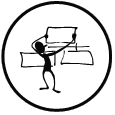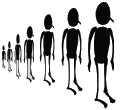
Understanding policy contexts


 |
Actor Analysis Understanding policy contexts |
  |
One of the difficulties we ecounter in the process is the lack of a validated hydrological model for the Bargerveen area. The maps that we have used to show the OGORs defined by the stakeholders are based on the elevation ("maaiveldhoogte") map. They do not convey any hydrological insights. To properly discuss the AGOR and OGORs, the participants should have such insights, at least at a rudimentary level. This made me think about an exercise that would allow participants to acquire such insights without the help of a model. I tested this exercise on 27 April 2007 with the help of our French community of practice on "facilitation et accompagnement des projets". The setup, process, and results are explained below.
The objective of the exercise is that the participants (1) develop a shared understanding of the actual ground water level in the Bargerveen area, and (2) identify the "knelpunten", i.e., those locations where the difference between their preferred water levels is such that compromise is very difficult to reach.
To reach these objectives, the participants are given these tasks:
To make the participants think for themselves about the groundwater level, no computer tools are used during the session. The maps and soil profile charts should be made beforehand. For want of a GIS, I used these two maps to obtain some basic data: the elevation map and the map showing the thickness of the peat layer.


I manually converted these two maps into an Excel worksheet with a limited resolution (20x25 cells) and a coarser scale.


I then made separate worksheets for two stacked line charts showing the ground surface (the elevation) and the peat layer underneath it, one for a North-South axis and one for an East-West axis, making sure that they would print on the same spatial scale, showing grid lines to facilitate reading the ground water heights.

Using these worksheets, I printed the soil profiles for all 20 N-S axes and all 25 E-W axes on separate sheets of A3 paper. I also printed the two maps (elevation and peat layer thickness), both in detail and as 20x25 matrix, and an areal photograph of the Bargerveen (obtained using Google Earth).

Having maps and charts on paper, I decided not to use a video projector. Instead, I wrote the agenda for the workshop and the objectives and outline of the tasks for the participants on flipcharts, and an explanation of the problem on the whiteboard.

The workshop took place on 27 April 2007, 10-13 hrs. The event was announced some weeks before in an open invitation sent to the mailing list of the community of practice, and an outline of the event was sent a week before the event. Eight people participated: Géraldine Abrami, David Crochet, Mathieu Dionnet, Clément Geney, Jean-Yves Jamin, Yorck von Korff, Olivier Naud, Dominique Rollin, and Jean-Emmanuel Rougier.
After a round of introduction where everyone shared some personal water-related experience (for example, I myself confessed having spilled a lot of water taking a shower, but that this was not really a waste because while showering I developed the idea for this workshop), I presented the Bargerveen context:




